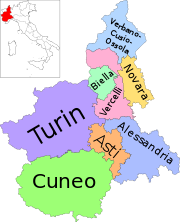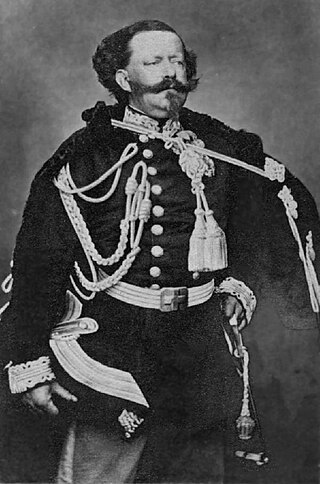
Victor Emmanuel II was King of Sardinia from 23 March 1849 until 17 March 1861, when he assumed the title of King of Italy and became the first king of an independent, united Italy since the 6th century, a title he held until his death in 1878. Borrowing from the old Latin title Pater Patriae of the Roman emperors, the Italians gave him the epithet of Father of the Fatherland.
Il Risorgimento was a liberal, nationalist newspaper founded in Turin 15 December 1847 by Camillo Benso, Count of Cavour and Cesare Balbo, who was a backbone of the "neo-Guelph" party that saw in future a rejuvenated Italy under a republican government with a papal presidency—ideas with which Cavour did not agree. The two men were soon joined by Pietro di Santa Rosa and Michelangelo Castelli, who soon assumed the position of vice-director. Publication began as a result of the relaxation of stringent press control which made the newspaper financially viable. Within weeks the paper, conceived as a weekly, was published daily, as revolutionary events, initiated by an insurgency in Palermo and demonstrations in Genoa, gained momentum. The paper was initiated to form a moderate middle-class "respectable" balance to the more radical "democratic" program of Concordia, which was initiated at the same time. The initial editorial by Cavour made the following claim: "Our aim not being of making money but of enlightening the country and of cooperating with the grand works of "Resurgence" initiated by the government".
Cavour usually refers to Camillo Benso, Count of Cavour (1810–1861), Italian politician who was a leading figure in the unification of Italy and became Italy's first Prime Minister. It may also refer to eponymous places and ships, among others.

Massimo Taparelli, Marquess of Azeglio, commonly called Massimo d'Azeglio, was a Piedmontese-Italian statesman, novelist, and painter. He was Prime Minister of Sardinia for almost three years until succeeded by his rival Camillo Benso, Count of Cavour. D'Azeglio was a moderate liberal and member of the Moderate Party associated with the Historical Right. He hoped for a federal union between Italian states.
Education in Italy is compulsory from 6 to 16 years of age, and is divided into five stages: kindergarten, primary school, lower secondary school, upper secondary school and university (università). Education is free in Italy and free education is available to children of all nationalities who are residents in Italy. Italy has both a private and public education system.
The Sant'Anna School of Advanced Studies is a special-statute, highly selective public research university located in Pisa, Italy.

The Liceo Italiano Statale Istanbul or the Istituti Medi Italiani (I.M.I.), popularly known as Liceo Italiano in Italian and İtalyan Lisesi in Turkish, is under legislation a private school which is situated in Beyoğlu, Istanbul, Turkey. Although considered a private school under Turkish law, the Liceo Italiano receives financial support and teachers from Italy.

Liceo scientifico is a type of secondary school in Italy. It is designed to give students the skills to progress to any university or higher educational institution. Students can attend the liceo scientifico after successfully completing middle school.

The liceo classico or ginnasio is the oldest public secondary school type in Italy. Its educational curriculum spans over five years, when students are generally about 14 to 19 years of age.
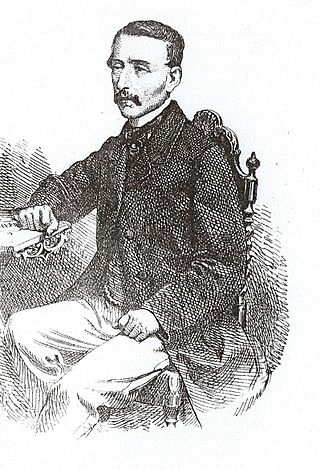
Carlo Ilarione Petitti count of Roreto was an Italian economist, academic, writer, counsellor of state, and senator of the Kingdom of Sardinia. He is seen as a prominent figure in the Italian Risorgimento.

A Superior Graduate School is a completely independent institution from a legal point of view, which offers advanced training and research through university-type courses or is dedicated to teaching at graduate or post-doctoral level.

General elections were held in Italy on 27 January 1861, with a second round on 3 February. The newly elected Parliament first convened in Turin on 4 March 1861, where, thirteen days later, it declared the unification of the country as the Kingdom of Italy.
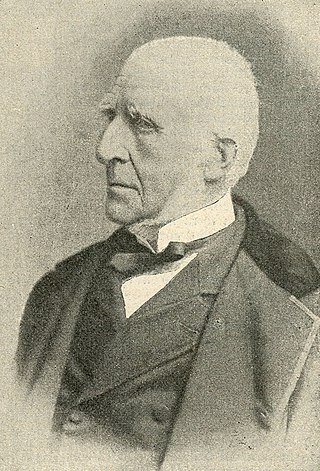
Luigi Ferraris was an Italian politician, who was Senator and minister in the Kingdom of Italy.

Camillo Paolo Filippo Giulio Benso, Count of Cavour, Isolabella and Leri, generally known as the Count of Cavour or simply Cavour, was an Italian politician, businessman, economist and noble, and a leading figure in the movement towards Italian unification. He was one of the leaders of the Historical Right and Prime Minister of the Kingdom of Sardinia, a position he maintained throughout the Second Italian War of Independence and Giuseppe Garibaldi's campaigns to unite Italy. After the declaration of a united Kingdom of Italy, Cavour took office as the first Prime Minister of Italy; he died after only three months in office and did not live to see the Roman Question solved through the complete unification of the country after the Capture of Rome in 1870.
The Moderate Party, collectively called Moderates, was an Italian pre-Unification political rally, active during the Risorgimento (1815–1861). The Moderates were never a formal party, but only a movement of liberal-minded reformist patriots, usually secular, from politics, military, literature and philosophy.

Giuseppe Natoli Gongora di Scaliti was an Italian lawyer and politician from the Mediterranean island of Sicily. He was Minister of Agriculture under Camillo Benso, Count of Cavour, in the first government of the Kingdom of Italy after unification in 1861.
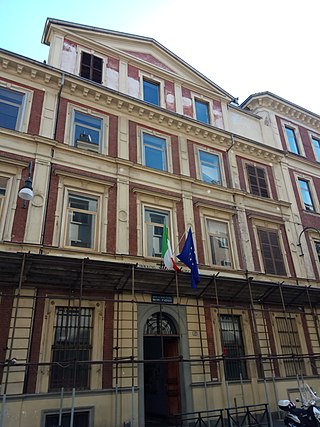
Liceo Classico Massimo d'Azeglio is a public sixth form college/senior high school in Turin, Italy. It is named after the politician Massimo d'Azeglio.

The Liceo statale "Niccolò Machiavelli" is a high school named after Niccolò Machiavelli located in the historic Oltrarno quarter of Florence, Italy. In the 2020 academic year it offered the secondary schools Liceo classico, Liceo delle Scienze Umane, Liceo Linguistico and Liceo Scientifico. It has a student population of over 1700, making it the second largest high school in the province. Initially based in the Fortezza da Basso, the school was moved Palazzo Rinuccini, in Via S. Spirito, in 2004. The branch of the school housing the international linguistic and international scientific departments is located in Palazzo Frescobaldi, also known as Della Missione. It is one of the oldest Italian normal schools for girls and has hosted the courses of one of the two Royal Higher Education Institutes.

The Kingdom of Sardinia is a term used to denote the Savoyard state from 1720 until 1861, which united the island of Sardinia with the mainland possessions of the House of Savoy. Before 1847, only the island of Sardinia proper was part of the Kingdom of Sardinia, while the other mainland possessions were held by the Savoys in their own right, hence forming a composite monarchy and a personal union which was formally referred to as the "States of His Majesty the King of Sardinia". This situation was changed by the Perfect Fusion act of 1847, which created a unitary kingdom. Due to the fact that Piedmont was the seat of power and prominent part of the entity, the state is also referred to as Sardinia-Piedmont or Piedmont-Sardinia and sometimes erroneously as the Kingdom of Piedmont.















